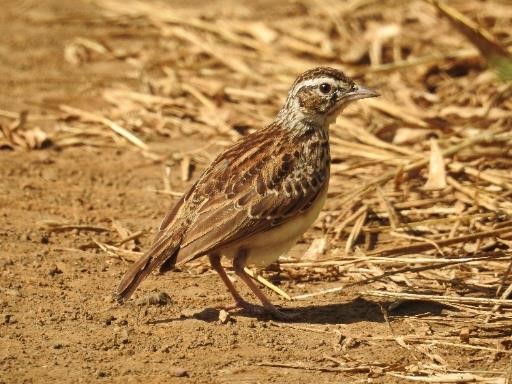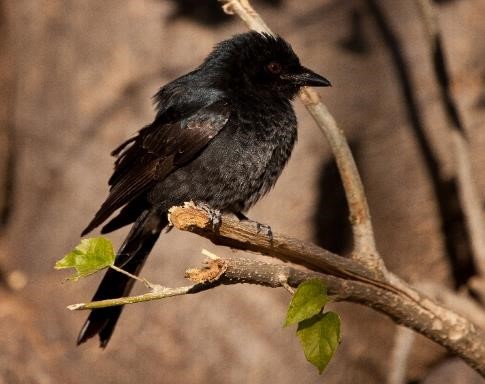November 2021
Mimicry in birds
Share:
Mimicry in birds
Singita Kruger National Park is well-known for the fantastic food that is served. We have incredible chefs. The food served to the staff, is also great. We tend to eat more home-style meals. These are usually accompanied by various vegetables or salads and the food is healthy and wholesome. The canteen is often a festive place where people gather at meal times and chat while they eat.
Recently we were sitting at one of the tables chatting to each other and eating our lunch when we heard the call of a white-faced whistling duck emanating from under the eaves of the roof. This was strange as ducks do not generally perch under the eaves of buildings. We looked carefully where the sound was coming from, but could not see anything. Next thing we could hear the call of a red-faced mousebird coming from the same area. Mousebirds are often seen in the area, but they also do not frequent buildings. The mousebird calls were then followed by the beautiful liquid sounds of a black-headed oriole and then the call of a dark-capped bulbul. We looked carefully where the sounds were coming from and then we saw it. The bird making the sounds was a male mocking cliff chat! He had just hopped out of the shadows of the eaves and we could see him nicely with his beautiful black, white and russet plumage. We watched him as he started calling again. This time he was calling like a tree squirrel.
We were amazed at how accurately he could mimic all the sounds of the other birds and the squirrels in the area. Mocking cliff chats are not the only birds in the area that mimic the sounds of other birds. Sabota larks are also very accomplished mimics (it is said that this species has been recorded to mimic up to 60 other bird calls), as are the red-capped robin-chats that visit Lebombo and Sweni Lodges during the winter months.
Another bird that also mimics other birds is the fork-tailed drongo.
This got me thinking as to why these birds would copy the calls of other birds and animals. One possible reason could be to impress mates. Perhaps by learning all the calls from other birds they are trying to show the females that they are either well-travelled or that they are obviously experienced and mature (as it would take time to learn all these other calls). Another reason could be to be socially accepted by the rest of their family or flock. This would be similar to humans having an accent or local jargon that other people from the same area would recognise. Some birds, like fork-tailed drongos are known to mimic the alarm calls of other birds or mammals in order to get them to drop their food and run for cover (thinking that another bird has seen something dangerous like a predator nearby). This type of behaviour has been documented in the drier western side of country where drongos that are following suricates / meerkats give alarm calls when they see that the small carnivores have caught something that looks tasty to the birds. The meerkats, hearing the alarm call think that a predatory bird of prey might be flying over and they quickly dash for the safety of a nearby burrow, often dropping the food in their haste. This tasty morsel is quickly picked up by the cheeky drongo! Mimicry may also help to protect nesting sites. By mimicking a bird of prey, a bird may be able to give the impression that a dangerous foe lives in the area, thus causing other predatory birds and nesting competitors to avoid the area. Fork-tailed drongos often mimic the calls of pearl-spotted owlets or African goshawks.
Perhaps learning the calls of other birds might just be accidental. Young nestlings learning the parent’s calls may hear other birds calling in the area close by the nest and accidentally incorporate these sounds into their own repertoire.
For whatever reason these mimics imitate other species it is still really impressive to hear how accurately they copy these sounds and it just reminds me to be careful when identifying birds in the area by their calls. It could possibly just be one of the mimics copying the sounds of another species!
Recently we were sitting at one of the tables chatting to each other and eating our lunch when we heard the call of a white-faced whistling duck emanating from under the eaves of the roof. This was strange as ducks do not generally perch under the eaves of buildings. We looked carefully where the sound was coming from, but could not see anything. Next thing we could hear the call of a red-faced mousebird coming from the same area. Mousebirds are often seen in the area, but they also do not frequent buildings. The mousebird calls were then followed by the beautiful liquid sounds of a black-headed oriole and then the call of a dark-capped bulbul. We looked carefully where the sounds were coming from and then we saw it. The bird making the sounds was a male mocking cliff chat! He had just hopped out of the shadows of the eaves and we could see him nicely with his beautiful black, white and russet plumage. We watched him as he started calling again. This time he was calling like a tree squirrel.
We were amazed at how accurately he could mimic all the sounds of the other birds and the squirrels in the area. Mocking cliff chats are not the only birds in the area that mimic the sounds of other birds. Sabota larks are also very accomplished mimics (it is said that this species has been recorded to mimic up to 60 other bird calls), as are the red-capped robin-chats that visit Lebombo and Sweni Lodges during the winter months.
Another bird that also mimics other birds is the fork-tailed drongo.
This got me thinking as to why these birds would copy the calls of other birds and animals. One possible reason could be to impress mates. Perhaps by learning all the calls from other birds they are trying to show the females that they are either well-travelled or that they are obviously experienced and mature (as it would take time to learn all these other calls). Another reason could be to be socially accepted by the rest of their family or flock. This would be similar to humans having an accent or local jargon that other people from the same area would recognise. Some birds, like fork-tailed drongos are known to mimic the alarm calls of other birds or mammals in order to get them to drop their food and run for cover (thinking that another bird has seen something dangerous like a predator nearby). This type of behaviour has been documented in the drier western side of country where drongos that are following suricates / meerkats give alarm calls when they see that the small carnivores have caught something that looks tasty to the birds. The meerkats, hearing the alarm call think that a predatory bird of prey might be flying over and they quickly dash for the safety of a nearby burrow, often dropping the food in their haste. This tasty morsel is quickly picked up by the cheeky drongo! Mimicry may also help to protect nesting sites. By mimicking a bird of prey, a bird may be able to give the impression that a dangerous foe lives in the area, thus causing other predatory birds and nesting competitors to avoid the area. Fork-tailed drongos often mimic the calls of pearl-spotted owlets or African goshawks.
Perhaps learning the calls of other birds might just be accidental. Young nestlings learning the parent’s calls may hear other birds calling in the area close by the nest and accidentally incorporate these sounds into their own repertoire.
For whatever reason these mimics imitate other species it is still really impressive to hear how accurately they copy these sounds and it just reminds me to be careful when identifying birds in the area by their calls. It could possibly just be one of the mimics copying the sounds of another species!

Sabota lark

Fork-tailed drongo
Sabota lark

By Brian Rode
Senior Field Guide